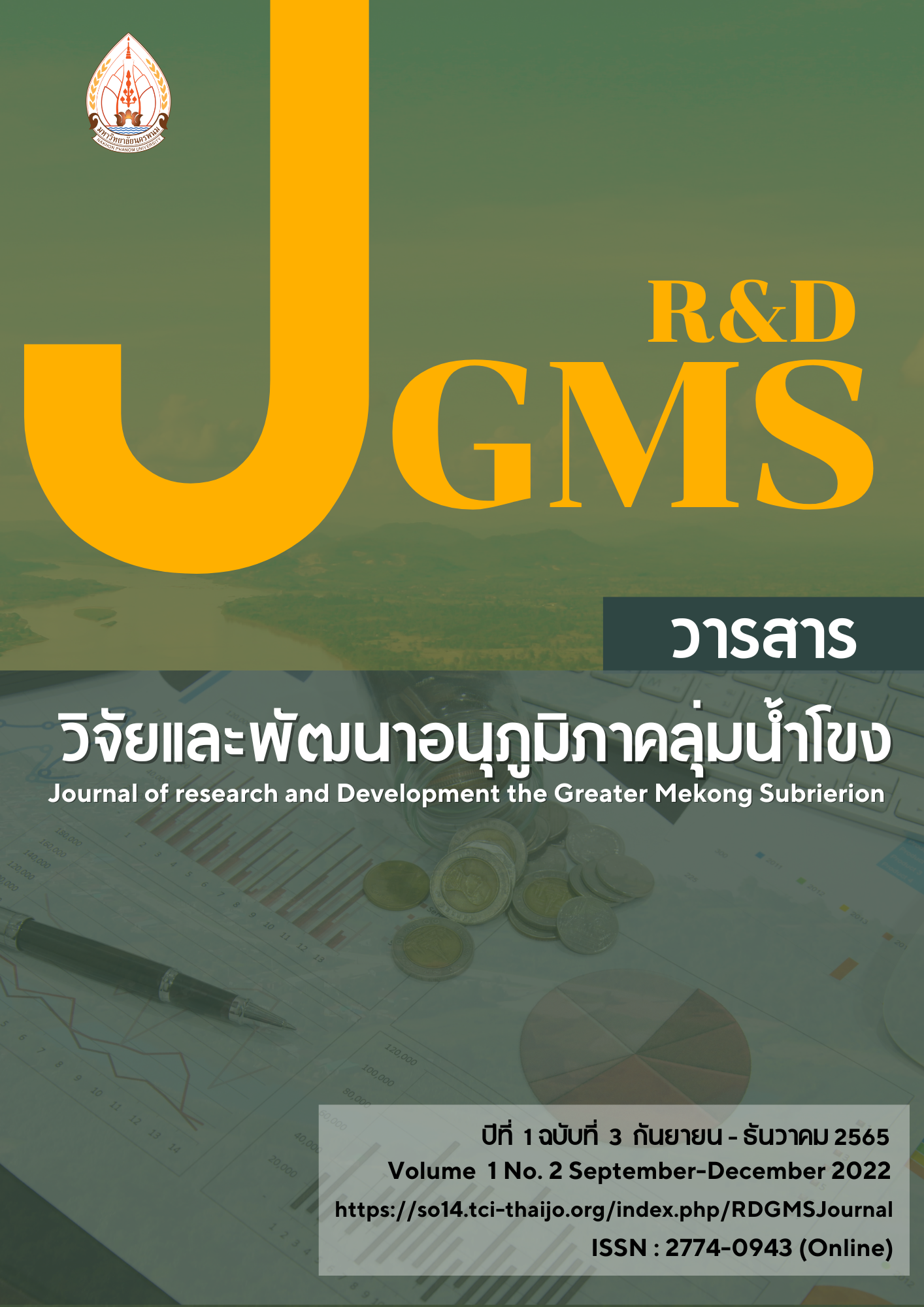ปริมาณสารออกฤทธิ์ทางชีวภาพและสารประกอบสาคัญ ที่มีประโยชน์ต่อสุขภาพในผลิตภัณฑ์ชาอัสสัม บ้านนาจอก จังหวัดนครพนม
Main Article Content
บทคัดย่อ
การวิจัยนี้ มีวัตถุประสงค์เพื่อวิเคราะห์ทำการศึกษาปริมาณสารออกฤทธิ์ทางชีวภาพและสารประกอบสำคัญที่มีประโยชน์ต่อสุขภาพในผลิตภัณฑ์ชาอัสสัมทั้งหมด 5 สูตรได้แก่ สูตรที่ 1 ชาอัสสัมอย่างเดียว, สูตรที่ 2 ชาอัสสัมกับอัญชัน, สูตรที่ 3 ชาอัสสัมกับดอกคาฝอย, สูตรที่ 4 ชาอัสสัมกับกระเจี๊ยบ และสูตรที่ 5 ชาอัสสัมกับดอกเก๊กฮวย พบว่า ใน สูตรที่ 2 ชาอัสสัมกับอัญชันมีปริมาณสารประกอบฟีนอลิกทั้งหมดสูงที่สุด เท่ากับ 115.79 mg GAE/ g (p<0.05) ส่วนปริมาณฟลาโวนอยด์ทั้งหมด พบว่าใน สูตรที่ 4 ชาอัสสัมกับกระเจี๊ยบ มีปริมาณฟลาโวนอยด์ทั้งหมดสูงที่สุด เท่ากับ 320.81 mg GAE/ g (p<0.05) ในส่วนประสิทธิภาพในการเป็นสารต้านอนุมูลอิสระ พบว่าใน สูตรที่ 4 ชาอัสสัมกับกระเจี๊ยบ มีประสิทธิภาพในการเป็นสารต้านอนุมูลอิสระสูงที่สุด เท่ากับ 68.51 mg TE/g sample, 331.32 mg FeSO4/ g sample (p<0.05) และพบว่าในสูตรที่ 4 ชาอัสสัมกับกระเจี๊ยบ มีปริมาณสารประกอบ Catechin และ Rutin สูงที่สุด เท่ากับ 328.40 และ 259.40 mg/100g (p<0.05) ตามลาดับ
Article Details

อนุญาตภายใต้เงื่อนไข Creative Commons Attribution-NonCommercial-NoDerivatives 4.0 International License.
ข้อเขียนหรือบทความใดๆ ที่ตีพิมพ์เผยแพร่ในวารสารวิจัยและพัฒนาอนุภูมิภาคลุ่มน้ำโขง (Online) ฉบับนี้ เป็นความคิดเห็นเฉพาะส่วนตัวของผู้เขียนและกองบรรณาธิการไม่จำเป็นต้องเห็นด้วย และวารสารวิจัยและพันาอนุภูมิภาค ลุ่มน้ำโขง (Online) ไม่มีข้อผูกพันธ์ประการใดๆ อนึ่งกองบรรณาธิการวารสารยินดีรับพิจารณาบทความจากนักวิชาการ นักศึกษา ตลอดจนผู้อ่าน และผู้สนใจทั่วไป เพื่อนำลงตีพิมพ์ สำหรับบทความจะผ่านการพิจารณาจากผู้ทรงคุณวุฒิสาขาวิชาที่เกี่ยวข้องทั้งภายในและภายนอกสถาบัน
เอกสารอ้างอิง
นภาภรณ์ และคณะ. 2552. ปัจจัยที่มีผลต่อสารฟีนอลิคของชาอัสสัม (Camellia sinensis) และองุ่น (Vitis vinifera) ที่เจริญในสภาพปลอดเชื้อ. วารสารวิทยาศาสตร์เกษตร, 40(3), 9-12.
สายลม สัมพันธ์เวชโสภา และคณะ. (2552). โครงการการเก็บและกาหนดพันธุ์ชาที่เหมาะสมในพื้นที่ปลูกภาคเหนือของประเทศไทย (รายงานการวิจัย พัฒนาและวิศวกรรม ฉบับสมบูรณ์). ศูนย์พันธุวิศวกรรมและเทคโนโลยีชีวภาพแห่งชาติ สานักงานพัฒนาวิทยาศาสตร์และเทคโนโลยีแห่งชาติ, กรุงเทพฯ.
Anthika, B., Kusumocahyo, S. P. & Sutanto, H. 2015. Ultrasonic approach in Clitoria ternatea (butterfly pea) extraction in water and extract sterilization by ultrafiltration for eye drop active ingredient. Procedia Chemistry, 16, 237-244.
Asgarpanah, J. and Kazemivash, N. 2013. “Phytochemistry, pharmacology and medicinal properties of Carthamus tinctorius L.” Chinese journal of integrative medicine. 19(2) : 153-159.
Cheng, W., J. Li, T. You and C. Hu. 2005. Anti-inflammatory and immunomodulatory activities of the extracts from the inflorescence of Chrysanthemum indicum Linné. J Ethnopharmacol. 101(1-3): 334-337.
Choi, K.T., J.H. Kim, H.T. Cho, S.S. Lim, S.S. Kwak and Y.J. Kim. 2016. Dermatologic evaluation of cosmetic formulations containing Chrysanthemum indicum extract. J Cosmet Dermatol.15(2): 162-168.
Chumroenphat, T., Somboonwatthanakul, I., Saensouk, S., & Siriamornpun, S. (2019). The diversity of biologically active compounds in the rhizomes of recently discovered Zingiberaceae plants native to North Eastern Thailand. Pharmacognosy Journal, 11(5).
Chumroenphat, T., Somboonwatthanakul, I., Saensouk, S., & Siriamornpun, S. (2021). Changes in curcuminoids and chemical components of turmeric (Curcuma longa L.) under freeze-drying and low-temperature drying methods. Food Chemistry, 339, 128121.
Higdon, J. V., & Frei, F. (2003). Tea catechins and polyphenols: Health effects, metabolism, and antioxidant functions. Critical Reviews in Food Science and Nutrition, 43(1), 89–143.
Kubola, Jittawan, Sirithon Siriamornpun, and Naret Meeso. 2011. “Phytochemicals,Vitamin C and Sugar Content of Thai Wild Fruits.” Food Chemistry 126(3): 972–81.
Machewad, G.M., Ghatge, P., Chappalwar, V., Jadhav, B. and Chappalwar, A. 2012. “Studies on Extraction of Safflower Pigments and its Utilization in Ice Cream.” Journal of Food Process Technology. 3 : 172. doi : 10.4172/2157-7110.1000172
Miguel, M. G. (2011). Anthocyanins: Antioxidant and/or anti-inflammatory activities. Journal of Applied Pharmaceutical Science, 1(6), 7-15.
Pereira, D. M., Valentão, P., Pereira, J. A. & Andrade, P. B. (2009). Phenolics: From chemistry to biology. Molecules, 14, 2,202-2,211.
Pinsuwan S, Ammuaikit TH, Ungphaiboon, Itharat A. liposome-containing Hibiscus sabdariffa calyx extract Formulations with increased antioxidant activity improve dermal penetration and reduced dermal toxicity. J Med Assoc Thai 2010;93:216-226.
Pradeep, P. M. & Sreerama, Y. N. (2015). Impact of processing on the phenolic profiles of small millets: Evaluation of their antioxidant and enzyme inhibitory properties associated with hyperglycemia. Food Chemistry, 169, 455-463.
Salem, N., Msaada, K., Hamdaoui, G., Limam, F., and Marzouk, B. 2011. “Variation in phenolic composition and Antioxidant activity during flower development of Safflower ( Carthamus tinctorius L.).” Journal of Agricultural and Food Chemistry. 59(9) : 4455 – 4463.
Siriamornpun, S., & Kaewseejan, N. (2017). Quality, bioactive compounds and antioxidant capacity of selected climacteric fruits with relation to their maturity. Scientia Horticulturae, 221, 33-42.
Tsai, P.J., McIntosh, J., Pearce, P., Camden, B. & Jordan, B. R. (2002). Anthocyanin and antioxidant capacity in Roselle (Hibiscus Sabdariffa L.) extract. Food Research International, 35, 351-356.
Wang, H., Provan, G. J., & Helliwell, K. (2000). Tea flavonoids, their functions, utilization and analysis. Trends Food Science Technology, 11, 152–160.
Wu LY, Gao HZ, Wang XL, Ye JH, Lu JL, Liang YR. Analysis of chemical composition of Chrysanthemum indicum flowers by GC/ MS and HPLC. J Med Plant Res. 2010;4(5): 421-6.
Yoon, H.R., Han H.G. and Paik, Y.S. 2007. “Flavonoid glycosides with antioxidant activity from the petals of Carthamus tinctorius.” Carbon. 1(2) : 3.


